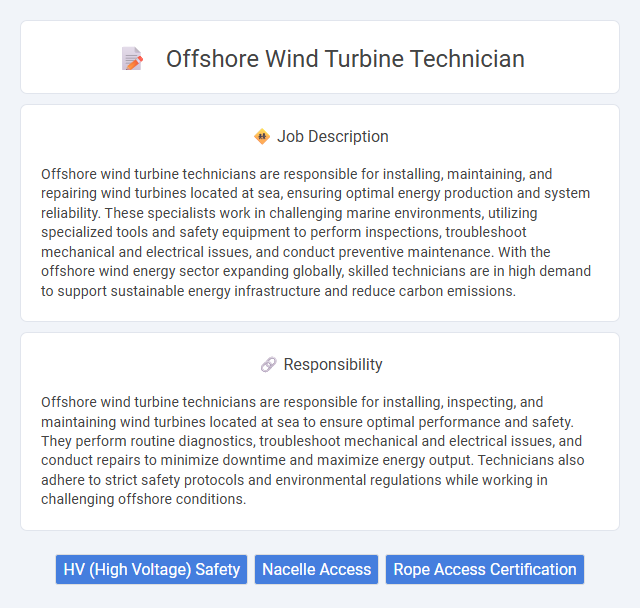
Offshore wind turbine technicians are responsible for installing, maintaining, and repairing wind turbines located at sea, ensuring optimal energy production and system reliability. These specialists work in challenging marine environments, utilizing specialized tools and safety equipment to perform inspections, troubleshoot mechanical and electrical issues, and conduct preventive maintenance. With the offshore wind energy sector expanding globally, skilled technicians are in high demand to support sustainable energy infrastructure and reduce carbon emissions.
Offshore wind turbine technician roles likely suit individuals with strong physical endurance and a tolerance for working in challenging, often harsh maritime environments. Candidates who are comfortable with heights, confined spaces, and unpredictable weather conditions probably have a higher chance of thriving in this job. Those who may struggle with physical demands or have anxiety about working offshore might find this role less suitable.
Qualification
Offshore wind turbine technicians require specialized training in electrical, mechanical, and safety skills, often obtained through accredited technical programs or apprenticeships. Certification in offshore survival and working at heights is mandatory due to the hazardous marine environment. Proficiency in troubleshooting, maintenance, and repair of turbine systems is essential for ensuring operational efficiency and safety compliance.
Responsibility
Offshore wind turbine technicians are responsible for installing, inspecting, and maintaining wind turbines located at sea to ensure optimal performance and safety. They perform routine diagnostics, troubleshoot mechanical and electrical issues, and conduct repairs to minimize downtime and maximize energy output. Technicians also adhere to strict safety protocols and environmental regulations while working in challenging offshore conditions.
Benefit
Working as an offshore wind turbine technician likely offers competitive salaries and opportunities for career advancement due to the specialized skills required. Employees probably benefit from extensive hands-on training and experience with cutting-edge technology, enhancing job security in a growing industry. Health and safety provisions may be robust, given the challenging offshore environment, potentially improving overall well-being and job satisfaction.
Challenge
The offshore wind turbine technician job likely involves working in physically demanding and often harsh marine environments, which can present significant safety and logistical challenges. Technicians probably need to regularly climb tall structures and perform maintenance tasks while exposed to strong winds and unpredictable weather conditions. Managing these risks effectively requires specialized training, technical skills, and resilience.
Career Advancement
Offshore wind turbine technicians experience significant career advancement opportunities within the renewable energy sector by mastering skills such as electrical systems, mechanical repairs, and safety protocols. Progression paths include senior technician roles, site supervisor positions, and specialized engineering roles, often accompanied by certifications from recognized bodies like the Global Wind Organisation (GWO). Continuous training and hands-on experience in cutting-edge offshore wind farms enhance employability and open doors to leadership or project management careers.
Key Terms
HV (High Voltage) Safety
Offshore wind turbine technicians specializing in High Voltage (HV) safety ensure the reliable operation and maintenance of electrical systems rated above 1,000 volts, minimizing risks of electric shock and arc flash incidents. They implement rigorous safety protocols, use personal protective equipment (PPE) designed for HV environments, and perform detailed inspections and tests to prevent electrical faults and failures. Expertise in potential hazards, emergency procedures, and regulatory compliance is critical for maintaining safe work conditions on offshore wind farms.
Nacelle Access
Offshore wind turbine technicians specializing in nacelle access perform critical maintenance and inspections at heights up to 100 meters. Expertise in rope access techniques and confined space safety protocols ensures efficient repairs and prevents turbine downtime. Proficiency in using harnesses, climbing gear, and emergency rescue equipment is essential for safe operation within the nacelle environment.
Rope Access Certification
Rope Access Certification is essential for offshore wind turbine technicians, enabling safe and efficient work at heights and in challenging marine environments. This certification ensures technicians are trained in advanced climbing, rescue techniques, and the use of specialized safety equipment critical for maintenance and inspection tasks. Mastery of rope access significantly enhances operational safety and reduces downtime in offshore wind farms.
 kuljobs.com
kuljobs.com